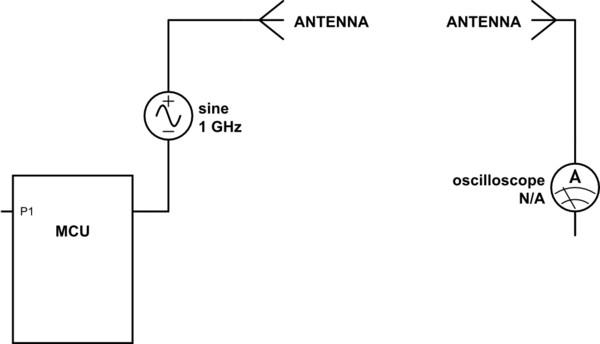I have previously used the NRF24L01 to transmit data between two microcontrollers. I have also used other radio transmitters and they all work great.
For purposes of learning I want to create a very simple radio transmitter. I do not want to get into the trouble of decoding the frequency into 0s and 1s. I just want to send a frequency over the air and capture it with an oscilloscope. If I create something like this will it work:

simulate this circuit – Schematic created using CircuitLab
On the left part I have a device that generates a 1 GHz pulse. That pulse is connected to a cable and the cable to an antenna.
On the right I have an antenna connected to an oscilloscope. Will the oscilloscope on the right read 1 GHz?
Lastly how large will my antenna have to be in order to capture a 1GHz radio signal?
Note I don't mind using a 433Mhz pulse instead than 1Ghz to make it easier. I am assuming 1Ghz will be easier because I don't want to have a large antenna
Reason why I want to do this:
I want to do this for purposes of learning and also because I have a project that runs from a battery. In order to save battery Arduino wakes up for 30ms in order to listen for a command. So it awakes listen for radio packets for 30ms and then go to sleep for 2 seconds. If I want to send a command to this receiver I will have to send pules every 5ms for up to 2 seconds. The reason why it takes so long is that the NRF24L01 takes 10ms to initialize then I have to send the listen command etc everything through ISP. It will be nice if I could have control of that myself in order to sleep for shorter amounts of time.
I still plan on using the NRF24L01 to transmit data. I just want to build something that will enable me to wake up my receiver fast. If my receiver is awake all the time then my battery will not last. I need a solution where my receiver wakes up for 2ms to check to see if it needs to become awake and then go to sleep for 1s..
